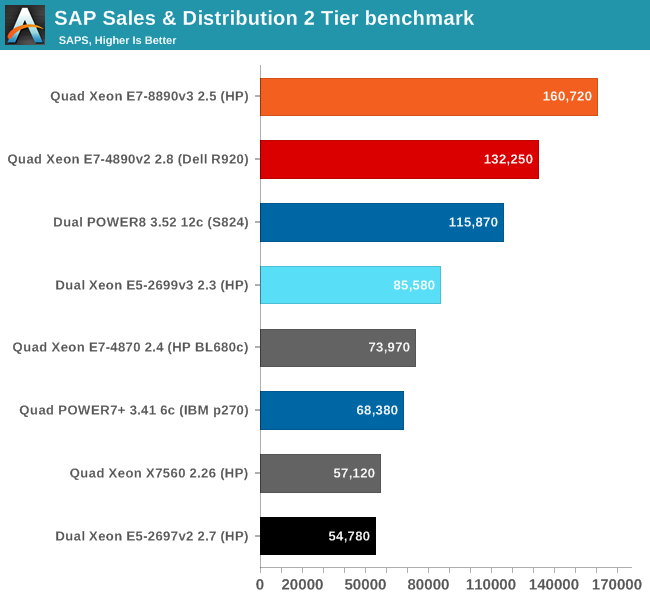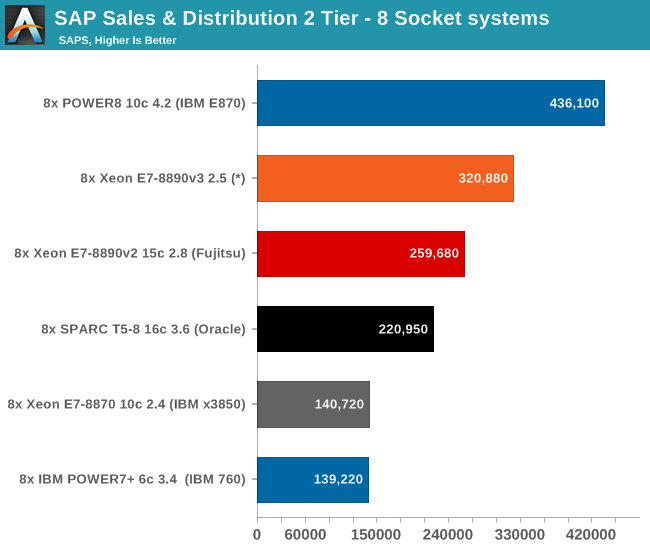The Intel Xeon E7-8800 v3 Review: The POWER8 Killer?
by Johan De Gelas on May 8, 2015 8:00 AM EST- Posted in
- CPUs
- IT Computing
- Intel
- Xeon
- Haswell
- Enterprise
- server
- Enterprise CPUs
- POWER
- POWER8
SAP S&D Benchmark
The SAP SD (Sales and Distribution, 2-Tier Internet Configuration) benchmark is an interesting benchmark as it is a real-world client-server application. It is one of those rare industry benchmarks that actually means something to the real IT professionals. Even better, the SAP ERP software is a prime example of where these Xeon E7 v2 chips will be used. We looked at SAP's benchmark database for these results.
Most of the results below all run on Windows 2008/2012 and MS SQL Server (both 64-bit). Every 2-Tier Sales & Distribution benchmark was performed with SAP's latest ERP 6 Enhancement Package 4. We analyzed the SAP Benchmark in-depth in one of our earlier articles. The profile of the benchmark has remained the same:
- Very parallel resulting in excellent scaling
- Low to medium IPC, mostly due to "branchy" code
- Somewhat limited by memory bandwidth
- Likes large caches (memory latency)
- Very sensitive to sync ("cache coherency") latency
Let's see how the quad Xeon compares to the previous Intel generation, the cheaper dual socket systems, and the RISC competition.

When we said that the competition in the high-end market was heating up, we were not kidding. The dual socket (24-core) S824 beats the dual socket Xeon E5 by a large margin (+35%), despite the latter having 50% more cores (36 vs 24).
At IBM's website, this server is priced at $65k, but the actual street prices are around $35k, slightly below what a typical similar quad Xeon costs (around $40k) .Of course, IBM should make it easier for small enterprises to get their hardware quickly at a decent price. But this shows that it is not impossible that POWER servers can become an alternative to the typical x86 systems... just not from IBM's webstore. The POWER8 system might be somewhat cheaper to acquire than the HP DL580 Gen9, but that Intel system is still almost 40% faster, so IBM is not an alternative quite yet. Then again, IBM is a lot more competitive than a few years ago. The S824 is not that far behind the Quad Xeon E7 v2, so it is a good thing that the new Xeon E7 offers about 20% better performance than the latter.
So who is on the top of server foodchain?

They might be power hungry, but the new POWER8 has made the Enterprise line of IBM more competitive than ever. Gone are the days that IBM needed more CPU sockets than Intel to get the top spot. Nevertheless, it should be noted that you can get several 8-socket Xeon systems for the price of one IBM E870 enterprise server.










146 Comments
View All Comments
Brutalizer - Tuesday, May 12, 2015 - link
Again, Hana is a clustered RAM database. And as I have shown above with the Oracle TenTimes RAM database, these are totally different from a normal database. In Memory DataBases can never replace a normal database, as IMDB are optimized for reading data (analysis), not modifying data.Regarding SGI UV300H, it is a 16 socket server, i.e. scale-up server. It is not a huge scale-out cluster. And therefore UV300H might be good for business software, but I dont know the performance of SGI's first(?) scale-up server. Anyway, 16 socket servers are different from SGI UV2000 scale out clusters. And UV2000 can not be used for business software. As evidenced by non existing SAP benchmarks.
ats - Wednesday, May 13, 2015 - link
No, you haven't shown anything. You quote some random whitepaper on the internet like it is gospel and ignore the fact that in memory dbs are used daily as the primary in OLTP, OLAP, BI, etc workloads.And you don't understand that a significant number of the IMDBs are actually designed directly for the OLTP market which is precisely the DB workload that is modifying the most data and is the most complex and demanding with regard to locks and updates.
There is no architecural difference between the UV300 and the UV2k except slightly faster interconnect. And just an fyi, UV300 is like SGI's 30th scale up server. After all, they've been making scale up server for longer than Sun/Oracle.
questionlp - Monday, May 11, 2015 - link
HP Superdome X is a 16-socket x86 server that will probably end up replacing the Itanium-based Superdome if HP can scale the S/X to 32 sockets.Brutalizer - Monday, May 11, 2015 - link
HP will face great difficulties if they try to mod and go beyond 8 sockets on the old Superdome. Heck, even 8 sockets have scaling difficulties on x86.Kevin G - Monday, May 11, 2015 - link
Except that you can you buy a 16 socket Superdome X *today*.http://h20195.www2.hp.com/V2/getpdf.aspx/4AA5-6149...
The interconnect they're using for the Superdome X is from the old Poulson Itaniums that use QPI which can scale to 64 sockets.
rbanffy - Wednesday, May 13, 2015 - link
You talk "serious business workloads". Of course, there are organizations that use technology that does not scale horizontally, where adding more machines to share the workload does not work because the workload was not designed to be shared. For those, there are solutions that offer progressively less performance per dollar for levels of single-box performance that are unattainable on high-end x86 machines, but that is just because those organizations are limited by the technology they chose.There is nothing in SAP (except its design) or (non-rel) databases that preclude horizontal scaling. It's just that the software was designed in an age when horizontal scaling was not in fashion (even though VAXes have been doing clustering since I was a young boy) and now it's too late to rebuild it from scratch.
mapesdhs - Friday, May 8, 2015 - link
Good point, I wonder why they've left it at only 2/core for so long...name99 - Friday, May 8, 2015 - link
It's not easy to ramp up the number of threads. In particular POWER8 uses something I've never seen any other CPU do --- they have a second tier register file (basically an L2 for registers) and the system dynamically moves data between the two register files as appropriate.It's also much easier for POWER8 to decode 8 instructions per cycle (and to do the multiple branch prediction per cycle to make that happen). Intel could maybe do that if they reverted to a trace cache, but the target codes for this type of CPU are characterized by very large I-footprints and not much tight looping, so trace caches, loop caches, micro-op caches are not that much help. Intel might have to do something like a dual-ported I-cache, and running two fetch streams into two independent sets of 4-wide decoders.
xdrol - Saturday, May 9, 2015 - link
Another register file is just a drop in the ocean. The real problem is the increasing L1/2/.. cache pressure; what can only be mitigated by increasing cache size; what in turn will make your cache access slower, even when you use only one of the SMT threads.Also, you need to have enough unused execution capacity (pipeline ports) for another hardware thread to be useful; the 2 threads in Haswell can already saturate the 7 execution ports with quite high probability, so the extra thread can only run in expense of the other, and due to the cache effects, it's probably faster to just get the 2 tasks executed sequentially (within the same thread). This question could be revisited if the processor has 14 execution port, 2x issue, 2x cache, 2x everything, so it can have 4T/1C, but then it's not really different from 2 normal size cores with 4T..
iAPX - Friday, May 8, 2015 - link
It's because this is the same architecture (mainly) that is used on desktop, laptops, and now even mobility!With this market share, I won't be surprised that Intel decided to create a new architecture (x86-64 based) for future server chips, much more specialized, dropping AVX for cloud servers, having 4+ threads per core with simpler decoder and a lot of integer and load/store units!
That might be complemented by a Xeon Phi socketable for floating-point compute intensive tasks and workstations, but it's unclear even if Intel announced it far far ago! ;)